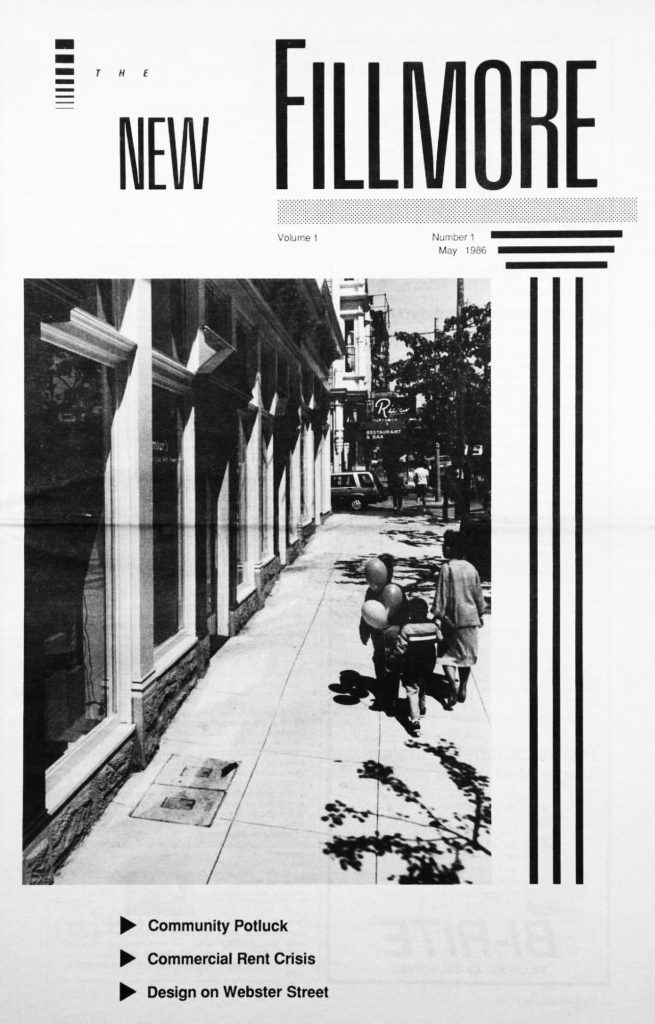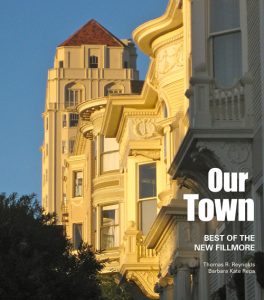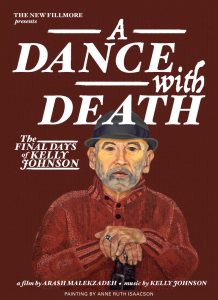
David Johnson and his iconic 1946 photograph in the 1300 on Fillmore lounge.
Photograph by Rory Earnshaw
A CONVERSATION with photographer David Johnson and his old friend and new wife, author Jacqueline Sue, as a new exhibition of his photographs of the Fillmore during the “Harlem of the West” era opens.
Jackie: In November we will have known each other for 58 years. Just a few weeks ago we celebrated your 88th birthday and our fifth wedding anniversary. Do you remember how we met?
David: Well, my wife Lucy and I and our two children were attending the Westside Christian Church at Bush and Divisadero. The mostly white congregation was interested in bringing more African-Americans to their church. A black pharmacist named Wayman Fuller who was a member invited my family, and we met you there.
Jackie: New in town, age 21, no friends, I was there because it was my family denomination in Kentucky and that was the only Christian Church in San Francisco.
David: You and Lucy bonded quickly and became friends because you were both among the first African-American long distance operators in the 1950s.
Jackie: When your son Michael was born in 1957 and I became his godmother, you were already an established photographer, but I didn’t realize it.
David: Yes, by then, I had photographed many of the historical photographs that are now being exhibited. My studio was on Divisadero Street not far from our church.
DAVID JOHNSON RETROSPECTIVE
David Johnson’s photographs are on view at the Harvey Milk Photo Center at 50 Scott Street from September 6 to October 19.
You see, as a youth growing up in Jacksonville, Florida, I found that I was curious about the neighborhood and environment where I lived. We were poor and living on the edge. However, my foster mother provided a good place for me to grow up.
After my discharge from the Navy following World War II, I decided to come to San Francisco and study photography with Ansel Adams at the California School of Fine Arts (now the San Francisco Art Institute). While Ansel and other students photographed Yosemite and nature, it was a natural fit for me to photograph people and the Fillmore community I lived in.
Jackie: I lived on many streets of the Fillmore. When I met you, I was living on California Street, not far from the old Grand Central Market, now Mollie Stone’s. Then I moved to Geary and Fillmore — that apartment is long gone, replaced by the underpass, just a block from where you photographed Looking South on Fillmore. How did you happen to take that shot?
David: I was always on the lookout for images that told a story. You know, I had to climb a scaffold at the old Bank of America building at Fillmore and Post with a large 4-by-5 view camera to take that picture. That was in 1946.
Jackie: I also lived at McAllister and Steiner. By now we were both working in the post office at Rincon Annex. Unions were just beginning to form and you were the president of the National Alliance of Postal Employees.
David: I was very active in the union and in local politics. I met many in the up-and-coming leadership of the black community when we were going to school and in the churches of the Fillmore neighborhood. I took photographs of Terry Francois, who was appointed by Mayor John Shelley as the first African-American to serve on the Board of Supervisors; Joseph Kennedy, first African-American appointed to the municipal court; Dr. Carlton Goodlett, publisher of the Sun Reporter newspaper and one-day-to-be California assemblyman Willie Brown. I photographed many of the national personalities, such as Thurgood Marshall, before he became a Supreme Court justice, and one of my favorite people, the poet Langston Hughes.
Jackie: You knew and photographed the San Francisco that was deemed “the Harlem of the West.” Your photographs of the classy people dressed for social events and lively jazz music are now a way for me and others to relive that magical time in the Fillmore District.
In 1964 I married Frank Sue, a San Francisco-born Chinese man and, like many minorities, we moved to the suburbs. For us it was Marin County.
David: Yes, but our families remained close. In the ’70s we all went to Haiti together, taking my youngest daughter with us. I still took pictures, but not as much. Through the Urban League, I took a job at UC Medical Center and eventually retired from there.
Jackie: Many years went by. I became a postmaster in Marin County, then went on to become a postal executive in Washington, D.C., finally retiring after 30 years. You and Lucy attended my 40th wedding anniversary celebration. Sadly, later in the year, my husband Frank Sue died of a heart attack.
David: Then, two years later, Lucy passed suddenly and my family was in shock, because she was the heart of our family.
Jackie: We renewed our friendship at our family Christmas party and it easily fell into place that we would make good marriage partners and do fun projects together, me as an author and you as a photographer.
David: Since we married, the recognition of my work has increased. Together at our Marin church we met Mindy Steiner, the filmmaker who did the documentary Positive Negatives on my life. The documentary allowed us to showcase my work not only in San Francisco, but in other cities — San Diego, Sacramento, Atlanta, Rochester, New York, and Washington, D.C.
Jackie: I wrote the book A Dream Begun So Long Ago: The Story of David Johnson, Ansel Adams’ First African American Student and now your exhibitions have increased tenfold.
David: Yes, including the wonderful exhibition opening September 6 at the Harvey Milk Photo Center in San Francisco. And there’s another book coming out next year titled The Golden Decade featuring the students of Ansel Adams from 1945 to 1955.
Jackie: Getting married led us to downsize and move to the Tamalpais retirement center in Greenbrae. But we are busier than ever.
David: I sang a song to you at our wedding, “Just in Time.” For me it really was true. I found you just in time.
EARLIER: “Photographer made his mark on Fillmore“
Filed under: Art & Design, Books, Video





